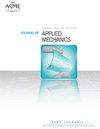A mechano-electro-chemical coupling model for bending analysis of single-stranded DNA-microbeam biosensors due to flexoelectricity
IF 2.8
4区 工程技术
Q2 MECHANICS
引用次数: 0
Abstract
Abstract Highly compliant structures such as microbeams can deform substantially in response to interactions between molecules adsorbed on their surface. To understand such systems and improve their detection signals, a mechano-electro-chemical coupling model for mechanical deformations of the microbeams immobilized single stranded DNA (ssDNA) is established due to flexoelectricity. The governing equations and corresponding boundary conditions of ssDNA-microbeams are derived by using the variational principle. The bending deformations of ssDNA-microbeams (one for cantilever beam and another for simply supported beam) are derived. The electric potential in the regions inside and outside the ssDNA layer is obtained by linear Poisson-Boltzmann equation for different electrolyte solutions. The analytical expressions to quantify the beam deflection and the potential difference of ssDNA layer are presented. The theoretical predictions are compared with the experimental data to validate the applicability of the present model. Numerical results reveal that the solution types, thickness and elastic modulus of substrate materials have obvious influence on the deflections of ssDNA-microbeams. Therefore, the present model can help to improve the reading of the bending deformation signal of the microbeam biosensors.单链dna -微束生物传感器挠性分析的机电耦合模型
高度柔顺的结构,如微梁,可以在其表面吸附的分子之间的相互作用下发生实质性的变形。为了更好地理解这类系统并改善其检测信号,本文建立了微束固定化单链DNA (ssDNA)在挠性电作用下机械变形的机电耦合模型。利用变分原理推导了ssdna微梁的控制方程和相应的边界条件。推导了ssdna微梁(悬臂梁和简支梁)的弯曲变形。利用线性泊松-玻尔兹曼方程得到了不同电解质溶液下ssDNA层内外区域的电势。给出了量化光束挠度和ssDNA层电位差的解析表达式。将理论预测结果与实验数据进行了比较,验证了模型的适用性。数值结果表明,溶液类型、衬底材料的厚度和弹性模量对ssdna微梁的挠度有明显影响。因此,该模型有助于提高微束生物传感器弯曲变形信号的读数。
本文章由计算机程序翻译,如有差异,请以英文原文为准。
求助全文
约1分钟内获得全文
求助全文
来源期刊
CiteScore
4.80
自引率
3.80%
发文量
95
审稿时长
5.8 months
期刊介绍:
All areas of theoretical and applied mechanics including, but not limited to: Aerodynamics; Aeroelasticity; Biomechanics; Boundary layers; Composite materials; Computational mechanics; Constitutive modeling of materials; Dynamics; Elasticity; Experimental mechanics; Flow and fracture; Heat transport in fluid flows; Hydraulics; Impact; Internal flow; Mechanical properties of materials; Mechanics of shocks; Micromechanics; Nanomechanics; Plasticity; Stress analysis; Structures; Thermodynamics of materials and in flowing fluids; Thermo-mechanics; Turbulence; Vibration; Wave propagation

 求助内容:
求助内容: 应助结果提醒方式:
应助结果提醒方式:


